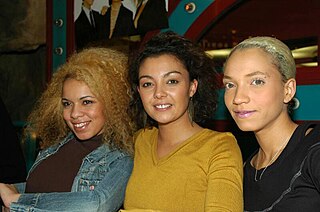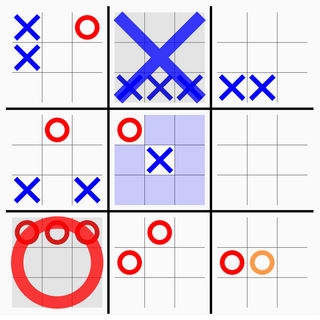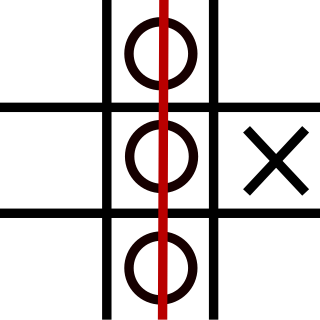A toe is a digit of the foot of a human or animal.
Contents
- Geography
- Arts, entertainment, and media
- Computing and technology
- Science and mathematics
- Other uses
- See also
Toe or TOE may also refer to:
A toe is a digit of the foot of a human or animal.
Toe or TOE may also refer to:

Tic-tac-toe, noughts and crosses, or Xs and Os is a paper-and-pencil game for two players who take turns marking the spaces in a three-by-three grid with X or O. The player who succeeds in placing three of their marks in a horizontal, vertical, or diagonal row is the winner. It is a solved game, with a forced draw assuming best play from both players.
Oxo or OXO may refer to:
TTT or Triple T may stand for:
In the context of Combinatorial game theory, which typically studies sequential games with perfect information, a game tree is a graph representing all possible game states within such a game. Such games include well-known ones such as chess, checkers, Go, and tic-tac-toe. This can be used to measure the complexity of a game, as it represents all the possible ways a game can pan out. Due to the large game trees of complex games such as chess, algorithms that are designed to play this class of games will use partial game trees, which makes computation feasible on modern computers. Various methods exist to solve game trees. If a complete game tree can be generated, a deterministic algorithm, such as backward induction or retrograde analysis can be used. Randomized algorithms and minimax algorithms such as MCTS can be used in cases where a complete game tree is not feasible.

3D tic-tac-toe, also known by the trade name Qubic, is an abstract strategy board game, generally for two players. It is similar in concept to traditional tic-tac-toe but is played in a cubical array of cells, usually 4×4×4. Players take turns placing their markers in blank cells in the array. The first player to achieve four of their own markers in a row wins. The winning row can be horizontal, vertical, or diagonal on a single board as in regular tic-tac-toe, or vertically in a column, or a diagonal line through four boards.
Spiegel is German, Yiddish, and Dutch for "mirror". More specifically, it may refer to:

Tic Tac Toe were a German girl group formed in 1995, performing pop-rap music. Their first two albums, Tic Tac Toe and Klappe die 2te, were million-selling commercial successes and spawned major hits "Ich find' dich scheiße", "Verpiss' dich" and "Warum?". The band found biggest popularity in German speaking countries, the Netherlands and Eastern Europe. Due to numerous scandals and personal issues between the group members, Tic Tac Toe split in 2001. The band had a successful but short-lived comeback in 2005 with the hit single "Spiegel", but ultimately disbanded in 2007.
Tic-Tac-Toe barb is a common name used for two separate species of barbs:
Mills is the plural form of mill, but may also refer to:

Quantum tic-tac-toe is a "quantum generalization" of tic-tac-toe in which the players' moves are "superpositions" of plays in the classical game. The game was invented by Allan Goff of Novatia Labs, who describes it as "a way of introducing quantum physics without mathematics", and offering "a conceptual foundation for understanding the meaning of quantum mechanics".
Harary's generalized tic-tac-toe or animal tic-tac-toe is a generalization of the game tic-tac-toe, defining the game as a race to complete a particular polyomino on a square grid of varying size, rather than being limited to "in a row" constructions. It was devised by Frank Harary in March 1977, and is a broader definition than that of an m,n,k-game.
Ellis is a surname.
Tic Tac is a brand of small, hard candy.

Tic Tac Toe is the debut studio album by German all-female pop-rap band Tic Tac Toe, released in 1996 by RCA Records. The lyrics and music were written by the band's manager Claudia Wohlfromm, her then-husband Torsten Börger, who also produced the album, and the band itself.
Tic Tac Toe may refer to:

Ultimate tic-tac-toe is a board game composed of nine tic-tac-toe boards arranged in a 3 × 3 grid. Players take turns playing on the smaller tic-tac-toe boards until one of them wins on the larger board. Compared to traditional tic-tac-toe, strategy in this game is conceptually more difficult and has proven more challenging for computers.

Wild tic-tac-toe is an impartial game similar to tic-tac-toe. However, in this game players can choose to place either X or O on each move. This game can also be played in its misere form where if a player creates a three-in-a-row of marks, that player loses the game.

Tic-tac-toe is an instance of an m,n,k-game, where two players alternate taking turns on an m×n board until one of them gets k in a row. Harary's generalized tic-tac-toe is an even broader generalization. The game can also be generalized as a nd game. The game can be generalised even further from the above variants by playing on an arbitrary hypergraph where rows are hyperedges and cells are vertices.
Treblecross is a degenerate tic-tac toe variant. The game is an octal game, played on a one-dimensional board and both players play using the same piece. Each player on their turn plays a piece in an unoccupied space. The game is won if a player on their turn makes a line of three pieces in a row.
Combinatorial Games: Tic-Tac-Toe Theory is a monograph on the mathematics of tic-tac-toe and other positional games, written by József Beck. It was published in 2008 by the Cambridge University Press as volume 114 of their Encyclopedia of Mathematics and its Applications book series (ISBN 978-0-521-46100-9).